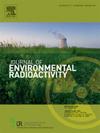罗纳河的放射性核素吸收动力学:实验和模拟方法。
IF 2.1
3区 环境科学与生态学
Q3 ENVIRONMENTAL SCIENCES
引用次数: 0
摘要
核设施排放到河流中的放射性核素的转移受其固体/液体分馏的制约,通常用分配系数Kd的平衡方法来表示。这个系数主要用于建模,它假定反应是瞬时的和完全可逆的。然而,这种假设很少得到证实。与放射性核素在粒子上的瞬时吸附相比,较慢的反应可能导致对溶解部分的低估,并且环境条件的改变(例如在汇合处、水坝等)可能导致固体/液体分配的变化。考虑到这一背景,本研究旨在评估是否包含一个或多个动力学模型来描述这种分馏允许比平衡方法更准确的估计。通过实验获得了一个大型数据集,对分馏模型进行了比较和测试。研究了法国罗纳河悬浮物与溶液中4种放射性核素(137Cs、60Co、54Mn和110mAg)的交换。从30分钟到2个月开始监测吸附动力学。数天后和2周后才稳定下来。在预先吸附1小时、3天、10天、21天和31天后,对污染悬浮液进行稀释,以模拟环境条件的变化,例如从支流输入未污染的水。稀释首先引起从固体到液体的快速释放,随后是所有四种放射性核素的意外重新吸附。31天的吸附数据用于拟合Kd模型和涉及一个(EK)或两个分馏动力学(KK)的衍生模型的参数。然后进行预测,以评估模型对污染稀释的反应能力。与恒定的Kd模型不同,动力学模型预测了固体/液体活度比随时间和环境条件变化的变化。然而,在一步吸附上建立的模型显示出再现稀释后观察到的吸附动力学的局限性,特别是当达到先前的稳态时。本文章由计算机程序翻译,如有差异,请以英文原文为准。
Radionuclide sorption dynamics in the Rhone River: Experimental and modelling approach
The transfer of radionuclides discharged into rivers by nuclear facilities are conditioned by their solid/liquid fractionation, commonly represented by an equilibrium approach using the distribution coefficient . This coefficient, largely used in modeling, assumes an instantaneous and completely reversible reaction. However, such assumptions are rarely verified. Compared to instantaneous adsorption of radionuclides onto particles, slower reactions may lead to an underestimation of the dissolved fraction, and modifications of environmental conditions (e.g. at confluences, dams …) may induce a change in solid/liquid partition. Considering this background, this study aims to assess whether models incorporating one or more kinetics to describe this fractionation allow more accurate estimations than the equilibrium approach. A large dataset has been obtained experimentally to compare and test fractionation models. The exchanges of four radionuclides (137Cs, 60Co, 54Mn, and 110mAg) between solution and riverine suspended particulate matter (from the Rhone River, France) were followed in laboratory. Adsorption kinetics were monitored starting from 30 min up to 2 months. They stabilized only after several days and up to 2 weeks. Dilutions of the contaminated suspension were carried out after 1 h, 3 days, 10, 21 and 31 days of prior adsorption, to simulate a change in environmental conditions, such as the input of uncontaminated water from a tributary. The dilution induced a quick release from solid to liquid at first, followed by a non-expected re-adsorption for all four radionuclides. 31-days sorption data were used to fit the parameters of a Kd model and derived models involving one (EK) or two fractionation kinetics (KK). Predictions were then carried out to evaluate the model capacities to react to a dilution of the contamination. Unlike the Kd model, which is a constant, the kinetic models predicted a variation in the solid/liquid activity ratio over time and when environmental conditions changed. However, models developed on one-step sorption showed limitations to reproduce the adsorption kinetics observed after a dilution, especially when a previous steady-state was reached.
求助全文
通过发布文献求助,成功后即可免费获取论文全文。
去求助
来源期刊

Journal of environmental radioactivity
环境科学-环境科学
CiteScore
4.70
自引率
13.00%
发文量
209
审稿时长
73 days
期刊介绍:
The Journal of Environmental Radioactivity provides a coherent international forum for publication of original research or review papers on any aspect of the occurrence of radioactivity in natural systems.
Relevant subject areas range from applications of environmental radionuclides as mechanistic or timescale tracers of natural processes to assessments of the radioecological or radiological effects of ambient radioactivity. Papers deal with naturally occurring nuclides or with those created and released by man through nuclear weapons manufacture and testing, energy production, fuel-cycle technology, etc. Reports on radioactivity in the oceans, sediments, rivers, lakes, groundwaters, soils, atmosphere and all divisions of the biosphere are welcomed, but these should not simply be of a monitoring nature unless the data are particularly innovative.
 求助内容:
求助内容: 应助结果提醒方式:
应助结果提醒方式:


